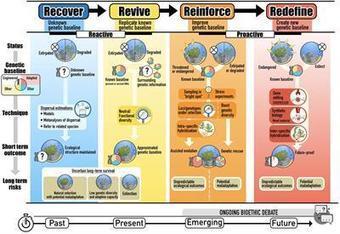Global habitat deterioration of marine ecosystems has led to a need for active interventions to halt or reverse the loss of ecological function. Restoration has historically been a key tool to reverse habitat loss and restore functions, but the extent to which this will be sufficient under future climates is uncertain. Emerging genetic technologies now provide the ability for restoration to proactively match adaptability of target species to predicted future environmental conditions, which opens up the possibility of boosting resistance to future stress in degraded and threatened habitats. As such, the choice of whether to restore to historical baselines or anticipate the future remains a key decision that will influence restoration success in the face of environmental and climate change. Here, we present an overview of the different motives for restoration – to recover or revive lost or degraded habitats to extant or historical states, or to reinforce or redefine for future conditions. We focus on the genetic and adaptive choices that underpin each option and subsequent consequences for restoration success. These options span a range of possible trajectories, technological advances and societal acceptability, and represent a framework for progressing restoration of marine habitat forming species into the future.

|
Scooped by Agrodoc Ouest |
La détérioration globale des habitats des écosystèmes marins a conduit à la nécessité d'interventions actives pour stopper ou inverser la perte de la fonction écologique. La restauration a toujours été un outil essentiel pour inverser la perte d'habitats et restaurer les fonctions, mais on ne sait pas dans quelle mesure cela sera suffisant sous les climats futurs. Les technologies génétiques émergentes permettent aujourd'hui de restaurer de manière proactive l'adaptabilité des espèces cibles aux conditions environnementales futures prévues, ce qui ouvre la possibilité de renforcer la résistance aux stress futurs dans les habitats dégradés et menacés. Ainsi, le choix de restaurer les bases historiques ou d'anticiper l'avenir reste une décision clé qui influencera le succès de la restauration face au changement environnemental et climatique. Nous présentons ici un aperçu des différentes motivations de la restauration - récupérer ou faire revivre les habitats perdus ou dégradés dans leur état actuel ou historique, ou renforcer ou redéfinir les conditions futures. Nous nous concentrons sur les choix génétiques et adaptatifs qui sous-tendent chaque option et sur les conséquences qui en découlent pour la réussite de la restauration. Ces options couvrent un éventail de trajectoires possibles, d'avancées technologiques et d'acceptabilité sociétale, et représentent un cadre pour faire progresser la restauration des espèces formant des habitats marins dans le futur.



 Your new post is loading...
Your new post is loading...







Auteurs : Coleman Melinda Ann, Wood Georgina, Filbee-Dexter Karen, Minne Antoine J. P., Goold Hugh Douglas, Vergés Adriana, Marzinelli Ezequiel Miguel, Steinberg Peter David, Wernberg Thomas
Frontiers in Marine Science, Vol 7, 2020, p.237
DOI=10.3389/fmars.2020.00237